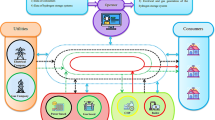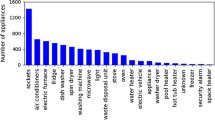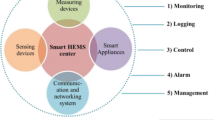Abstract
Due to the significant gap between demand and supply of electricity, power utility companies employ rolling blackouts, in which the power supply to different regions is cut-off periodically for a specified duration. However, this causes increased user inconvenience as consumers are left without power; also, a large undesirable blackout may occur if the circuit breakers are not opened in time. To solve this problem, this paper has developed a more pragmatic approach in which a power threshold limit is imposed on households during times of deficit power supply. This paper presents five algorithms designed to allocate load thresholds to households in a fair manner. Some of these algorithms perform the worst (high violations) in some time slots and best (minimal violations) in other slots, but none guarantees minimal mean violation across all the time slots. In this regard, this paper has also developed a novel optimal algorithm that ensures a minimal violation percentage of the allotted thresholds across all time slots in all the households of a neighbourhood. It also employs multiple heuristics for threshold allocation, thereby preventing household starvation. The algorithms are evaluated on a real-world dataset. Its mean violation across all the houses goes as low as nearly 45% and is minimum across all the time slots. It performs all the algorithms used for power limit distribution. This result demonstrates the effectiveness of the developed technique in the implementation of the brownout scheme in practise.













Similar content being viewed by others
Data Availibility
The dataset (publicly available) used for evaluation of the developed algorithms can be found at https://traces.cs.umass.edu/index.php/smart/smart.
References
Alsalloum, H., Merghem-Boulahia, L., & Rahim, R. (2020). Hierarchical system model for the energy management in the smart grid: A game theoretic approach. Sustainable Energy, Grids and Networks, 21(100), 329. https://doi.org/10.1016/j.segan.2020.100329
Baba, M. F. (2012). Smart grid with adsl connection for solving peak blackouts in west bank. In 2012 First international conference on renewable energies and vehicular technology (pp. 270–273). https://doi.org/10.1109/REVET.2012.6195282
Barker, S., Mishra, A., Irwin, D., et al. (2012). Smart*: An open data set and tools for enabling research in sustainable homes. In Proceedings of the ACM SustKDD, August 12, 2012. Association for Computing Machinery, New York, USA
Bin-Halabi, A., Nouh, A., & Abouelela, M. (2018). Interactive energy management system to avoid rolling blackouts. In 2018 5th international conference on electric power and energy conversion Systems (EPECS) (pp. 1–7)
Blume, S., & Sons, J.W. (2016). electric power system basics: for the nonelectrical professional. In IEEE Press series on power engineering. Wiley-Interscience, https://books.google.co.in/books?id=lxFrnQAACAAJ
Cai, Y., Lu, Z., Pan, Y., et al. (2022). Optimal scheduling of a hybrid ac/dc multi-energy microgrid considering uncertainties and Stackelberg game-based integrated demand response. International Journal of Electrical Power & Energy Systems, 142(108), 341. https://doi.org/10.1016/j.ijepes.2022.108341
Chen, L., Tang, H., Wu, J., et al. (2022). A robust optimization framework for energy management of CCHP users with integrated demand response in electricity market. International Journal of Electrical Power & Energy Systems, 141(108), 181. https://doi.org/10.1016/j.ijepes.2022.108181
Ebrahimi, J., Abedini, M., & Rezaei, M. M. (2020). Optimal scheduling of distributed generations in microgrids for reducing system peak load based on load shifting. Sustainable Energy, Grids and Networks, 23(100), 368. https://doi.org/10.1016/j.segan.2020.100368
Eia.gov (2018) EIA - Electricity Data. https://www.eia.gov/electricity/monthly/epm_table_grapher.php?t=epmt_5_01
Feldman, M., Lai, K., & Zhang, L. (2009). The proportional-share allocation market for computational resources. IEEE Transactions on Parallel and Distributed Systems, 20(8), 1075–1088. https://doi.org/10.1109/TPDS.2008.168
Ferraz, B. P., Pereira, L. A., Lemos, F., & Haffner, S. (2020). Residential demand response based on weighted load shifting and reduction target. Journal of Control, Automation and Electrical Systems, 31, 422–435. https://doi.org/10.1007/s40313-019-00517-3
Gellings, C. W. (1981). Power/energy: Demand-side load management: The rising cost of peak-demand power means that utilities must encourage customers to manage power usage. IEEE Spectrum, 18(12), 49–52. https://doi.org/10.1109/MSPEC.1981.6369703
Gellings, C. W. (2009). The smart grid: Enabling energy efficiency and demand response. New York: Fairmont Press.
Golmohamadi, K. R. H. (2017). Application of robust optimization approach to determine optimal retail electricity price in presence of intermittent and conventional distributed generation considering demand response. Journal of Control, Automation and Electrical Systems, 28, 664–678. https://doi.org/10.1007/s40313-017-0328-9
Jain, A., Smarra, F., Behl, M., et al. (2018). Data-driven model predictive control with regression trees-an application to building energy management. ACM Transactions on Cyber-Physical Systems. https://doi.org/10.1145/3127023
Kelkar, S., Kothari, N., & Ramamritham, K. (2015). Brownout energy distribution scheme for mitigating rolling blackouts. In Proceedings of the 2015 ACM sixth international conference on future energy systems. Association for computing machinery, New York, NY, USA, e-Energy ’15 (pp. 193–194). https://doi.org/10.1145/2768510.2770937
Kumar, G.K., Maniadarsh, S., Thungeshwaran, R., et al. (2020). Remotely controllable consumer perspective demand response using genetic algorithm. In: 2020 fourth international conference on I-SMAC (IoT in social, mobile, analytics and cloud) (I-SMAC) (pp. 904–9080. https://doi.org/10.1109/I-SMAC49090.2020.9243490
Laabid, A., Saad, A., & Mazouz, M. (2022). Integration of renewable energies in mobile employment promotion units for rural populations. Civil Engineering Journal, 8(7), 1406–1434. https://doi.org/10.28991/CEJ-2022-08-07-07
Lawton, P. (2012). Balancing the energy network. Ingenia, 53, 20–26.
Lee, J.Y., Choi, S.G. (2014). Linear programming based hourly peak load shaving method at home area. In: 16th international conference on advanced communication technology (pp. 310–313). https://doi.org/10.1109/ICACT.2014.6778971
Levine, G. N. (1989). The control of starvation. International Journal of General Systems, 15(2), 113–127. https://doi.org/10.1080/03081078908935036
Mahmood, A., Ullah, M., Razzaq, S., et al. (2014). A new scheme for demand side management in future smart grid networks. Procedia Computer Science 32, 477–484. https://doi.org/10.1016/j.procs.2014.05.450, the 5th International Conference on Ambient Systems, Networks and Technologies (ANT-2014), the 4th International Conference on Sustainable Energy Information Technology (SEIT-2014)
Mansouri, S., Ahmarinejad, A., Sheidaei, F., et al. (2022). A multi-stage joint planning and operation model for energy hubs considering integrated demand response programs. International Journal of Electrical Power & Energy Systems, 140(108), 103. https://doi.org/10.1016/j.ijepes.2022.108103
Mishra, M. K., & Parida, S. K. (2020). A game theoretic approach for demand-side management using real-time variable peak pricing considering distributed energy resources. IEEE Systems Journal. https://doi.org/10.1109/JSYST.2020.3033128
Ndwali, N. J. W. E. P. K. (2020). Optimal operation control of microgrid connected photovoltaic-diesel generator backup system under time of use tariff. Journal of Control, Automation and Electrical Systems, 31, 1001–1014. https://doi.org/10.1007/s40313-020-00585-w
Onyeka, F. C., & Mama, B. O. (2021). Analytical Study of Bending Characteristics of an Elastic Rectangular Plate using Direct Variational Energy Approach with Trigonometric Function. Emerging Science Journal, 5(6), 2021. https://doi.org/10.28991/esj-2021-01320
Popa, F. (2007). On Pareto efficiency and equitable allocations of resources. Romanian Economic Journal, 10(23), 73–79.
Raj, B. D., Kumar, S., Padhi, S., et al. (2018). Brownout based blackout avoidance strategies in smart grids. In: Proceedings of the ninth international conference on future energy systems. Association for computing machinery, New York, e-Energy ’18 (pp. 456–458). https://doi.org/10.1145/3208903.3212059
Rastegar, M., Fotuhi-Firuzabad, M., & Lehtonen, M. (2015). Home load management in a residential energy hub. Electric Power Systems Research, 119, 322–328. https://doi.org/10.1016/j.epsr.2014.10.011
Rocha, H. R., Soares, W. C., Silvestre, L. J., Celeste, W. C., Junior, L. O. R., Coura, D. J., & Silva, J. A. (2023). Identification of similar electrical loads in smart homes with 100% accuracy provided by a convolutional neural network with minimum parameters. Journal of Control, Automation and Electrical Systems, 34(1), 137–149.
Salimian, M. R., & Aghamohammadi, M. R. (2018). A three stages decision tree-based intelligent blackout predictor for power systems using brittleness indices. IEEE Transactions on Smart Grid, 9(5), 5123–5131.
Shafie-Khah, M., Talari, S., Wang, F., et al. (2020). Decentralised demand response market model based on reinforcement learning. IET Smart Grid, 3(5), 713–721. https://doi.org/10.1049/iet-stg.2019.0129
Silberschatz, A., Galvin, P. B., & Gagne, G. (2012). Operating System Concepts, 9th. edn. Wiley Publishing
Silva, B. N., Khan, M., & Han, K. (2020). Futuristic sustainable energy management in smart environments: A review of peak load shaving and demand response strategies, challenges, and opportunities. Sustainability. https://doi.org/10.3390/su12145561
Soundarabai, P., Thriveni, J., Venugopal, K. R., & Patnaik, L. M. (2012). Comparative study on load balancing techniques in distributed systems. International Journal of Information Technology and Knowledge Management, 6(1), 53–60.
Stamatescu, G., Stamatescu, I., Arghira, N., et al. (2019). Data-driven modelling of smart building ventilation subsystem. Journal of Sensors, 2019, 1–14. https://doi.org/10.1155/2019/3572019
Strbac, G. (2008). Demand side management: Benefits and challenges. Energy Policy, 36(12), 4419–4426. https://doi.org/10.1016/j.enpol.2008.09.030
Subbiah, R., Pal, A., Nordberg, E., et al. (2017). Energy demand model for residential sector: A first principles approach. IEEE Transactions on Sustainable Energy, 8, 1215–1224.
Tahiri, F. E., Chikh, K., & Khafallah, M. (2021). Optimal management energy system and control strategies for isolated hybrid Solar–Wind–Battery–Diesel power system. Emerging Science Journal, 5(2), 111–124. https://doi.org/10.28991/esj-2021-01262
Thang, V., Ha, T., Li, Q., et al. (2022). Stochastic optimization in multi-energy hub system operation considering solar energy resource and demand response. International Journal of Electrical Power & Energy Systems, 141(108), 132. https://doi.org/10.1016/j.ijepes.2022.108132
Vyakaranam, B., Vallem, M., Nguyen, T., et al. (2017). A study of the impact of peak demand on increasing vulnerability of cascading failures to extreme contingency events. In: 2017 IEEE power & energy society general meeting (pp. 1–5). https://doi.org/10.1109/PESGM.2017.8274656
Wierzbicki, A. (2014). Trust and Fairness in Open. Distributed Systems. https://doi.org/10.1007/978-3-642-13451-7
Wyatt, A. (1986). Electric power: Challenges and choices. Toronto: The Book Press Limited.
Author information
Authors and Affiliations
Corresponding author
Ethics declarations
Conflict of interest
The authors did not receive support from any organization for the submitted work. The authors have no relevant financial or non-financial interests to disclose.
Additional information
Publisher's Note
Springer Nature remains neutral with regard to jurisdictional claims in published maps and institutional affiliations.
Rights and permissions
Springer Nature or its licensor (e.g. a society or other partner) holds exclusive rights to this article under a publishing agreement with the author(s) or other rightsholder(s); author self-archiving of the accepted manuscript version of this article is solely governed by the terms of such publishing agreement and applicable law.
About this article
Cite this article
Agarwal, A. FAlloc: A Fair Power Limit Allocation-Based Approach to Implement Brownout. J Control Autom Electr Syst 35, 361–375 (2024). https://doi.org/10.1007/s40313-024-01077-x
Received:
Revised:
Accepted:
Published:
Issue Date:
DOI: https://doi.org/10.1007/s40313-024-01077-x




